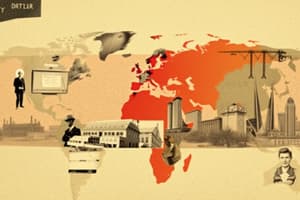Podcast
Questions and Answers
What is globalization primarily about?
What is globalization primarily about?
- The isolation of nations from each other.
- The focus on a single country's economy.
- The interaction and integration among individuals and nations worldwide. (correct)
- The end of international trade.
Which of the following best describes the global economy?
Which of the following best describes the global economy?
- Only the production of goods without any trade.
- A collection of independent economic actions with no relationships between countries.
- The interconnected economic activities and relationships between countries worldwide. (correct)
- Economic activities conducted only within a single nation.
How can globalization be exemplified by modern consumer behavior?
How can globalization be exemplified by modern consumer behavior?
- Buying a smartphone made in another country. (correct)
- Employing only domestic labor for manufacturing.
- Refusing to use technology from other nations.
- Purchasing only local products.
Which activity is NOT typically included in the concept of the global economy?
Which activity is NOT typically included in the concept of the global economy?
What major aspect does globalization enhance between countries?
What major aspect does globalization enhance between countries?
What was the period from 1945 to 1973 known as?
What was the period from 1945 to 1973 known as?
Which organization was established to stabilize the global economy by providing financial assistance to member countries?
Which organization was established to stabilize the global economy by providing financial assistance to member countries?
What was the primary purpose of the General Agreement on Tariffs and Trade (GATT)?
What was the primary purpose of the General Agreement on Tariffs and Trade (GATT)?
Which major economic event does the Bretton Woods Conference directly relate to?
Which major economic event does the Bretton Woods Conference directly relate to?
What significant economic change occurred in the international monetary system in the 1970s?
What significant economic change occurred in the international monetary system in the 1970s?
Flashcards are hidden until you start studying
Study Notes
Globalization and the Global Economy
- Globalization involves increased interaction and integration among people, companies, and governments globally, leading to interconnectedness and interdependence.
- It encompasses cross-border trade, technology exchange, investment flow, and information sharing.
- Example of globalization: Purchasing a smartphone designed in the US, manufactured in China, and sold in the Philippines illustrates global trade links.
Components of the Global Economy
- The global economy includes all economic activities—production, consumption, trade, and financial transactions—that occur between countries.
- Example: Coffee from Brazil sold in Japan and German cars bought in the US demonstrate cross-border exchanges.
- Countries are interconnected economically, impacting each other through trade and investments.
Post-World War II Economic System
- "The Golden Age of Capitalism" (1945-1973) marked by rapid growth, high employment, and rising living standards in Western nations.
- Establishment of institutions like IMF, World Bank, and GATT aimed at stabilizing the economy and fostering international cooperation.
- Example: Increased household appliance ownership reflects economic improvements during this period.
International Monetary Fund (IMF)
- Aims to stabilize the global economy by providing financial assistance and advice to member nations, especially those with balance of payments issues.
- Established at the Bretton Woods Conference in 1944 by influential figures including John Maynard Keynes and Harry Dexter White.
- Example: IMF assistance to Greece during its debt crisis illustrates its role in economic stabilization.
Bretton Woods Conference
- Held in July 1944, gathering 44 Allied nations to establish a framework for international economic cooperation post-WWII.
- Key outcomes included the creation of the IMF and World Bank to promote stability and development.
- John Maynard Keynes promoted government intervention in the economy to mitigate recessions.
- Harry Dexter White contributed significantly to the establishment of the Bretton Woods system.
World Bank
- Provides financial and technical support for development projects in poorer countries, focusing on education, health, and infrastructure.
- Also established in 1944 at the Bretton Woods Conference.
- Example: Funding for rural school construction improves education access and economic opportunities.
GATT and WTO
- GATT facilitated international trade by reducing trade barriers like tariffs and quotas.
- The WTO replaced GATT, continuing to regulate international trade and resolve disputes among countries.
- Example: Agreements to lower tariffs on imported goods promote trade by reducing costs.
International Monetary System
- Comprised of rules and institutions that facilitate international trade and investment among countries with different currencies.
- Significant transition occurred from fixed to floating exchange rates in the 1970s, enhancing flexibility in trade.
- Example: Currency value fluctuations allow responsive adjustments to market conditions, impacting trade dynamics.
Trade Orders: Unilateral vs. Multilateral
- Unilateral Trade Order: Countries independently set trade rules and tariffs, potentially leading to conflicts.
- Multilateral Trade Order: Multiple countries collaborate to establish common trade regulations, fostering fairness and reducing barriers.
- Example: The establishment of the WTO signifies the move towards cooperative trade practices.
Transition from Keynesianism to Neoliberalism
- Keynesianism argues for government intervention to stabilize the economy, particularly during downturns, promoting social spending and infrastructure investment.
- Neoliberalism prioritizes free markets, deregulation, and reduced government roles in economic processes, advocating for privatization and free trade.
- Example: The UK's policy shift in the 1980s reflects a transition from Keynesian intervention to neoliberal strategies emphasizing market efficiency.
Studying That Suits You
Use AI to generate personalized quizzes and flashcards to suit your learning preferences.




